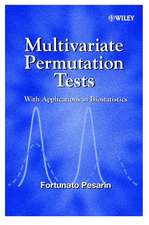Exploring Mathematical Modeling in Biology Through Case Studies and Experimental Activities
Autor Rebecca Sanft, Anne Walteren Limba Engleză Paperback – 31 mar 2020
Included case studies focus on building a model to solve a particular biological problem from concept and translation into a mathematical form, to validating the parameters, testing the quality of the model and finally interpreting the outcome in biological terms. The book also shows how particular mathematical approaches are adapted to a variety of problems at multiple biological scales. Finally, the labs bring the biological problems and the practical issues of collecting data to actually test the model and/or adapting the mathematics to the data that can be collected.
- Presents a single volume on mathematics and biological examples, with data and wet lab experiences suitable for non-experts
- Contains three real-world biological case studies and one wet lab for application of the mathematical models
- Includes R code templates throughout the text, which are also available through an online repository, along with the necessary data files to complete all projects and labs
Preț: 574.22 lei
Preț vechi: 753.19 lei
-24% Nou
Puncte Express: 861
Preț estimativ în valută:
109.87€ • 115.03$ • 90.92£
109.87€ • 115.03$ • 90.92£
Carte tipărită la comandă
Livrare economică 31 martie-14 aprilie
Preluare comenzi: 021 569.72.76
Specificații
ISBN-13: 9780128195956
ISBN-10: 0128195959
Pagini: 254
Dimensiuni: 191 x 235 mm
Greutate: 0.45 kg
Editura: ELSEVIER SCIENCE
ISBN-10: 0128195959
Pagini: 254
Dimensiuni: 191 x 235 mm
Greutate: 0.45 kg
Editura: ELSEVIER SCIENCE
Public țintă
Students and researchers in biomedical engineering, computational biology, mathematics, computer science and life sciences who are interested in understanding and applying mathematical modellingCuprins
Unit 1 Introduction to Modeling using Difference Equations1.1 Discrete-Time Models 1.1.1 Solutions to First-Order Difference Equations1.1.2 Using Linear Regression to Estimate Parameters 1.2 Putting it all together: The Whooping Crane 1.3 CaseStudy1: Island Biogeography1.3.1 Background1.3.2 Model Formulation1.3.3 Rakata Story1.3.4 Modern Approach: Lineage Data1.3.5 Back to MacArthur and Wilson: Effects of Distance and Area1.4 CaseStudy2: Pharmacokinetics Model1.4.1 Background1.4.2 Formulating the model1.4.3 Understanding the Model 1.4.4 Parameter Estimation 1.4.5 Model Evaluation/Analysis1.4.6 Further Exploration 1.5 CaseStudy3: Invasive Plant Species1.5.1 Background1.5.2 Model Formulation 1.5.3 Parameter Estimation1.5.4 Model Predictions1.5.5 Management Strategies 1.6 Wet Lab: Logistic Growth Model of Bacterial Population Dynamics 1.6.1 Introduction 1.6.2 Modeling populations 1.6.3 The Experiment 1.6.4 Model Calibration and Analysis1.6.5 Experiment Part2: Effect of changing Media
Unit 2 Differential Equations: Model Formulation, Nonlinear Regression, and Model Selection 2.1 Biological Background 2.2 Mathematical and R Background2.2.1 Differential Equation Based Model Formulation 2.2.2 Solutions to Ordinary Differential Equations 2.2.3 Investigating Parameter Space2.2.4 Nonlinear Fitting2.3 Model Selection2.4 Case Study 1: How Leaf Decomposition Rates Vary with Anthropogenic Nitrogen Deposition2.4.1 Background2.4.2 The Data2.4.3 Model Formulation2.4.4 Parameter Estimation 2.4.5 Model Evaluation2.5 Case Study 2: Exploring Models to Describe Tumor Growth Rates 2.5.1 Background2.5.2 The Data 2.5.3 Model Formulation2.5.4 Parameter Estimation 2.5.5 Model Evaluation: Descriptive Power 2.5.6 Model Evaluation: Predictive Power 2.6 Case Study 3: Predator Responses to Prey Density Vary with Temperature 2.6.1 Background2.6.2 Analysis of functional response data: determining the parameters 2.6.3 Exploring functional responses as a function of temperature2.7 Wet Lab: Enzyme Kinetics of Catechol Oxidase2.7.1 Overview of Activities 2.7.2 Introduction to Enzyme Catalyzed Reaction Kinetics 2.7.3 Deriving the model2.7.4 Estimating KM and Vmax2.7.5 Our Enzyme: Catechol Oxidase 2.7.6 Experiment: Collecting Initial Rates for the Michaelis-Menten Model2.7.7 Effects of Inhibitors on Enzyme Kinetics2.7.8 Experiment: Measuring the Effects of Two Catechol Oxidase Inhibitors, Phenylthiourea and Benzoic Acid
Unit 3 Differential Equations: Numerical Solutions, Model Calibration, and Sensitivity Analysis3.1 Biological Background 3.2 Mathematical and R Background3.2.1 Numerical Solutions to Differential Equations 3.2.2 Calibration: Fitting Models to Data 3.2.3 Sensitivity Analysis 3.2.4 Putting it all together: The Dynamics of Ebola Virus Infecting Cells3.3 Case Study: Influenza: Adapting the Classic SIR Model to the 2009 Influenza Pandemic 3.3.1 Background3.3.2 The SIR Model3.3.3 Cumulative Number of Cases 3.3.4 Epidemic Threshold 3.3.5 Public Health Interventions 3.3.6 2009 H1N1 Influenza Pandemic3.4 Case Study 2: Prostate Cancer: optimizing immuno-therapy 3.4.1 Background3.4.2 Model Formulation3.4.3 Model Implementation3.4.4 Parameter Estimation3.4.5 Vaccination Protocols and Model Predictions 3.4.6 Sensitivity Analysis 3.4.7 Simulating Other Treatment Strategies3.5 Case Study 3: Quorum Sensing3.5.1 Introduction 3.5.2 Model Formulation3.5.3 Parameter Estimation 3.5.4 Model Simulations 3.5.5 Sensitivity Analysis 3.6 Wet Lab: Hormones and Homeostasis—Keeping Blood Glucose Concentrations Stable 3.6.1 Overview of Activities3.6.2 Introduction to blood glucose regulation and its importance 3.6.3 Developing a model 3.6.4 Experiment: Measuring Blood Glucose Concentrations Following Glucose Ingestion3.6.5 Analysis3.6.6 Thoughts to Consider for Potential Follow-up Experiments
Unit 4 Technical Notes for Laboratory Activities 4.1 Introduction4.2 Population Growth4.3 Enzyme Kinetics 4.3.1 Notes on other enzymes or similar experiments 4.4 Instructor Notes for the Blood Glucose Monitoring Lab 4.4.1 Tips for glucose monitoring 4.4.2 Other Lab Activities
Unit 2 Differential Equations: Model Formulation, Nonlinear Regression, and Model Selection 2.1 Biological Background 2.2 Mathematical and R Background2.2.1 Differential Equation Based Model Formulation 2.2.2 Solutions to Ordinary Differential Equations 2.2.3 Investigating Parameter Space2.2.4 Nonlinear Fitting2.3 Model Selection2.4 Case Study 1: How Leaf Decomposition Rates Vary with Anthropogenic Nitrogen Deposition2.4.1 Background2.4.2 The Data2.4.3 Model Formulation2.4.4 Parameter Estimation 2.4.5 Model Evaluation2.5 Case Study 2: Exploring Models to Describe Tumor Growth Rates 2.5.1 Background2.5.2 The Data 2.5.3 Model Formulation2.5.4 Parameter Estimation 2.5.5 Model Evaluation: Descriptive Power 2.5.6 Model Evaluation: Predictive Power 2.6 Case Study 3: Predator Responses to Prey Density Vary with Temperature 2.6.1 Background2.6.2 Analysis of functional response data: determining the parameters 2.6.3 Exploring functional responses as a function of temperature2.7 Wet Lab: Enzyme Kinetics of Catechol Oxidase2.7.1 Overview of Activities 2.7.2 Introduction to Enzyme Catalyzed Reaction Kinetics 2.7.3 Deriving the model2.7.4 Estimating KM and Vmax2.7.5 Our Enzyme: Catechol Oxidase 2.7.6 Experiment: Collecting Initial Rates for the Michaelis-Menten Model2.7.7 Effects of Inhibitors on Enzyme Kinetics2.7.8 Experiment: Measuring the Effects of Two Catechol Oxidase Inhibitors, Phenylthiourea and Benzoic Acid
Unit 3 Differential Equations: Numerical Solutions, Model Calibration, and Sensitivity Analysis3.1 Biological Background 3.2 Mathematical and R Background3.2.1 Numerical Solutions to Differential Equations 3.2.2 Calibration: Fitting Models to Data 3.2.3 Sensitivity Analysis 3.2.4 Putting it all together: The Dynamics of Ebola Virus Infecting Cells3.3 Case Study: Influenza: Adapting the Classic SIR Model to the 2009 Influenza Pandemic 3.3.1 Background3.3.2 The SIR Model3.3.3 Cumulative Number of Cases 3.3.4 Epidemic Threshold 3.3.5 Public Health Interventions 3.3.6 2009 H1N1 Influenza Pandemic3.4 Case Study 2: Prostate Cancer: optimizing immuno-therapy 3.4.1 Background3.4.2 Model Formulation3.4.3 Model Implementation3.4.4 Parameter Estimation3.4.5 Vaccination Protocols and Model Predictions 3.4.6 Sensitivity Analysis 3.4.7 Simulating Other Treatment Strategies3.5 Case Study 3: Quorum Sensing3.5.1 Introduction 3.5.2 Model Formulation3.5.3 Parameter Estimation 3.5.4 Model Simulations 3.5.5 Sensitivity Analysis 3.6 Wet Lab: Hormones and Homeostasis—Keeping Blood Glucose Concentrations Stable 3.6.1 Overview of Activities3.6.2 Introduction to blood glucose regulation and its importance 3.6.3 Developing a model 3.6.4 Experiment: Measuring Blood Glucose Concentrations Following Glucose Ingestion3.6.5 Analysis3.6.6 Thoughts to Consider for Potential Follow-up Experiments
Unit 4 Technical Notes for Laboratory Activities 4.1 Introduction4.2 Population Growth4.3 Enzyme Kinetics 4.3.1 Notes on other enzymes or similar experiments 4.4 Instructor Notes for the Blood Glucose Monitoring Lab 4.4.1 Tips for glucose monitoring 4.4.2 Other Lab Activities















